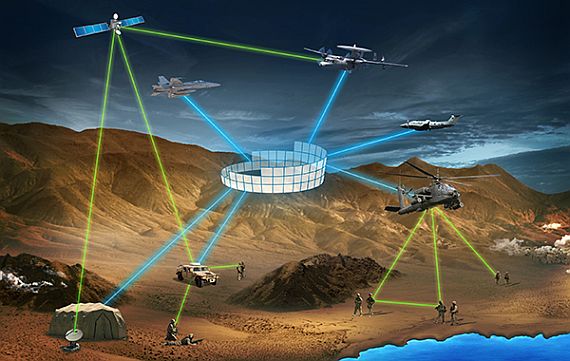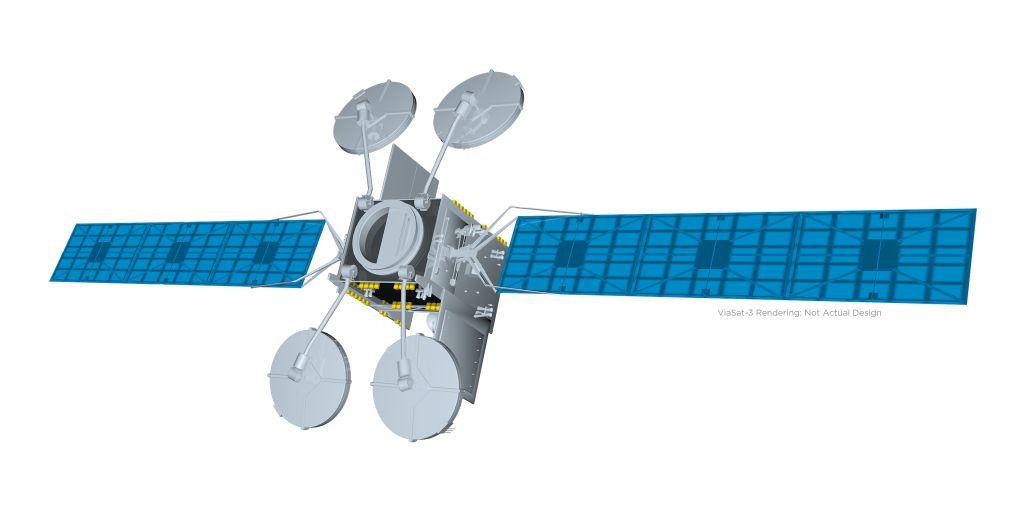By Chuck Black
PROVIDING SECURE COMMUNICATIONS ACROSS THE BATTLESPACE
Ask Ken Peterman, the president of government systems at Carlsbad California-based ViaSat Inc., what he knows about the future of the Canadian military’s command, control, communication and computer infrastructure and the requirements needed to build that infrastructure, and he’ll tell you that it will include wireless and satellite communications, comprise the same cost effective private sector commercial capabilities which built the modern civilian internet, but will also support those capabilities with the strong, secure encryption needed to maintain necessary secrecy in the modern military environment.
 Those tools will allow for the roll-out of high-bandwidth, secure, cloud based and wireless/satellite communication channels, which won’t just help the generals. The technology will also connect together ships, aircraft, land vehicles and even individual soldiers and sailors into a seamless and interconnected whole.
Those tools will allow for the roll-out of high-bandwidth, secure, cloud based and wireless/satellite communication channels, which won’t just help the generals. The technology will also connect together ships, aircraft, land vehicles and even individual soldiers and sailors into a seamless and interconnected whole.
Peterman’s career spans over 30 years, with experience in general management, systems engineering, strategic planning, portfolio management, and business leadership in the aerospace and defence industries. He joined ViaSat in April 2013 as vice president, government systems. In June 2014, he was appointed senior vice president, government systems, and assumed his current position in May 2017.
So he knows what he’s talking about.
INVESTING IN CANADA
“ViaSat is investing in Canada,” said Peterman during a recent interview with CDR, citing the company’s double digit sales growth in this country over the last few years, plus its focus on cybersecurity and expertise with “unique Canadian cyber security requirements” relating to bilingualism and the Canadian regulatory framework.
He also noted ViaSat’s ability to achieve compliance with the operational and security requirements of the international “Five Eyes” network, a longstanding alliance between Australia, Canada, New Zealand, the United Kingdom and the United States, countries with a similar common law legal inheritance, who share signals, military and human intelligence.
Taken together, these capabilities provide essential “one stop shopping” for those tasked with “the protection and management of the nation’s critical information and networks,” according to Peterman.
Peterman noted that ViaSat, one of the top 100 US defence companies by revenue, is already very active in Canada.
For example, in September 2016 the company signed a contract with Richmond, BC based MacDonald Dettwiler and Associates Ltd. (MDA) allowing MDA to establish a repair, maintenance and upgrade service for ViaSat’s Link 16 military communication terminals, which are currently deployed across Canada supporting Department of National Defence (DND) operations.
WORKING WITH MDA IN CANADA
MDA will use its existing facilities across Canada to perform this operational support, resulting in a decreased maintenance time, and reduced cost to the CAF. The repair and maintenance service will eventually grow into an intermediate maintenance facility (I-Level), as additional terminals and radios are deployed throughout the Canadian military.
The Link 16 series of interoperable terminals (including the world’s only handheld Link 16 radio for soldiers in the field), software tools and other supporting services are offered
to prospective ViaSat customers as a method of gaining 360 degree situational awareness on the battlefield and there is much truth to that perspective.
The proven resiliency, reliability and anti-jamming capabilities of the Link 16 terminal (first developed in the 1970’s and operationally deployed with the US military since the mid-1980’s) plus its ability to be used on aircraft, ships, ground platforms and by dismounted war fighters to exchange data is certainly useful to help disperse the “fog of war.”
Specifically, the Royal Canadian Air Force uses the ViaSat KOR-24A small tactical terminal (STT) on its CP-140 (Aurora) aircraft for global airborne surveillance and “command, control, communications, computers, intelligence, surveillance and reconnaissance” (C4ISR) missions. As the only simultaneous two-channel radio in the world, ViaSat’s STT enables the CP-140 Aurora aircraft to maintain constant presence on the Link 16 network while simultaneously operating voice and data connections on a second channel.
The ViaSat STT is interoperable across all other Link 16-enabled platforms (Halifax-Class Frigates, CF-18 Hornets and fixed/mobile ground stations), which ensures secure, efficient communications between Canadian and Allied forces.
In addition to the Link 16 capabilities, ViaSat has worked with the Canadian Department of National Defence (CDND) to provide access to the ViaSat ‘best available’ global satellite network for secure, high-speed data streaming and connectivity for in-flight ISR missions across the world.
APPLICABLE TO FWSAR
According to Peterman, ViaSat’s military capabilities are directly applicable to existing and future Canadian platforms such as fixed wing search and rescue (FWSAR) operations utilizing naval, ground and air assets. The ViaSat tools, including Link 16 and the variety of high performance antenna systems, gateways and hubs, are configurable to utilize both satellite communications assets and earth-based line of sight capabilities.
Best of all, Link 16 and its components are the most widely used tactical communications of the U.S. and its coalition partners worldwide, a state of affairs which is certainly worth noting for those looking to avoid “blue on blue” engagements and assist individual soldiers with the “real-time situational awareness” needed to prevent friendly fire and save lives.
ViaSat also competes in the civilian sector. The company provides civilian broadband internet satellite services to help support connections to remote communities, such as the popular Xplornet wireless carrier and rural internet service provider, which uses the ViaSat-1 140 Gigabit per second (Gbps) satellite.
This expertise is useful when it comes to the custom design, construction and support of “trusted networks” under the secure control of an in-house network manager or administrator. These networks are prevalent in the oil, gas and energy industries to support critical infrastructures, which makes them important components of existing and future Canadian energy generation and distribution systems.
It also makes them an area of intense private sector rivalry which helps competitive companies like ViaSat build capabilities and develop new skills.
PARTNERING WITH TELESAT
As well, ViaSat has an ongoing partnership with Ottawa, Ontario-based Telesat, which goes back to 2011 when Telesat concluded an agreement with Loral Space & Communications Inc. to acquire the Canadian payload of the ViaSat-1 satellite. At the time, Telesat CEO Dan Goldberg called the partnership “ideally suited to meet the strong demand for broadband services to rural Canada,” and the satellites’ performance over the last few years certainly seems to have validated his judgement.
It’s quite possible that many of us have come into contact with ViaSat products and capabilities during business or personal travel without even knowing it. Amongst its many endeavours, the company provides in-flight internet, onboard entertainment and flight operations for commercial airlines.
“It’s important to note that the private sector is now outpacing government when it comes to connecting and communication,” said Peterman. “This commercial perspective will save money and help roll out solutions quickly, but needs to be welded to a deep understanding of defence requirements in order to ensure security.”
According to Peterman, “ViaSat can do that. It has the private sector tools for government sector work and comes with both the required deep defence knowledge and a strong commercial background.”
OWNING AND OPERATING SATELLITES
ViaSat’s core capabilities are highlighted by ViaSat-1 and ViaSat-2, two of the satellites it currently owns and operates, along with the uprated capabilities anticipated when the three satellites of the ViaSat-3 series begin to come online. The first two of the ViaSat-3 series are currently expected to launch consecutively in 2019 and 2020.
ViaSat-1 held the Guinness record for the world’s highest capacity communications satellite with a total capacity in excess of 140 Gbps, when it was launched October 19th, 2011 on a Russian Proton “Breeze M” rocket.
At the time, that was more throughput than all the other satellites covering North America.
The 6,800 kg ViaSat-1 remains parked in a geostationary orbit above North America at 115.1° West longitude where it continues to provide broadband internet service coverage and general communications services. It’s expected to have a 15-year operational life. From a Canadian perspective, the satellite provides coverage up to 50 degrees latitude and is able to service up to a million Canadians.
ViaSat-2, launched on June 1st, 2017 on board a French Ariane 5 rocket, will become the new holder of that Guinness record when it becomes operational in early 2018.
With an anticipated throughput of more than 300 Gbps, the 6,800 kg satellite will provide satellite broadband internet to areas in the U.S., throughout North America, parts of South America, the Caribbean, and the Atlantic Ocean. ViaSat also offers satellite internet for business, live events, field operations, and disaster response.
In essence, ViaSat-2 will extend service coverage to 70+ degrees latitude and provide capacity for most of North America.
VIASAT 3 TAKES CAPABILITY TO A WHOLE NEW LEVEL
ViaSat’s next class of satellites, known as the ViaSat-3 platform, is expected to raise the satellite capacity even further than the ViaSat-2 capabilities. Each ViaSat-3 satellite will have an estimated throughput of 1 Terabit per second (Tbps) per satellite, and will have nearly triple the throughput of ViaSat-2, whose 300+ Gbps is also more than double the 140 Gbps of ViaSat-1.
And, much like what was once true of ViaSat-1, each individual ViaSat-3 next generation satellite is expected to have more throughput capacity than all the other telecommunications spacecraft in the world when it launches.
The pattern in these numbers is obvious – although the numbers, by themselves, might lack context and not automatically lead to useful conclusions.
The real story, at least according to Peterman, is far more interesting. The more data ViaSat satellites can transmit, the more security protocols and protections can be layered over the core data to ensure security. The extra bandwidth will allow for increased multimedia capacity and the transmission of large amounts of data, useful in a wide array of circumstances ranging from combat situations to disaster relief operations.
“We are in an era where military communications will require only a portion of the potential civilian bandwidth,” Peterman told CDR, “and with the appropriate security, essential services in military and government can piggyback on top of those lower cost civilian systems, using encryption to allow for the transfer of classified data across public networks already in existence.”
Commercial networks are designed to allow the massive expansion of the amounts of data, images, audio and video. With demand expanding almost exponentially in recent years, a collateral benefit is the availability of this expanded capacity for military needs.
NEXT GEN MILITARY INTERNET
But, the satellites, the terminals and the other tools currently employed and expected to be deployed by the Canadian Forces in the future, along with the Canadian partnerships developed up until now are really only an intermediary step in the creation of the next generation military internet.
In order to support ViaSat’s increasing capabilities, the company is beginning to solicit other Canadian based sub-contractors.
 These include (but are not limited to) contract electronic systems and electronics enclosure manufacturers; companies and academic centres skilled in the art of Ka/Ku communications technologies, or with experience in satellite ground stations, antennas, and Ka/Ku band applications; experience with software defined, dual capability military radios similar to the Link-16/Satcom series; companies experienced with infrastructure services for complex military installations in remote locations; and other industrial and academic collaborators working “at the cutting edge of crypto and cyber technologies.”
These include (but are not limited to) contract electronic systems and electronics enclosure manufacturers; companies and academic centres skilled in the art of Ka/Ku communications technologies, or with experience in satellite ground stations, antennas, and Ka/Ku band applications; experience with software defined, dual capability military radios similar to the Link-16/Satcom series; companies experienced with infrastructure services for complex military installations in remote locations; and other industrial and academic collaborators working “at the cutting edge of crypto and cyber technologies.”
“We’re looking for help and believe that Canada can have a big role to play in our mission,” according to Peterman. He understands that ViaSat needs the participation of critical Canadian partners and suppliers. “Currently, we are proud to count MDA, Xplornet and Telesat Canada as important collaborators. However, to achieve our goals we know we must broaden and strengthen this team,” he believes.
Anyone looking to create a mutually beneficial relationship, addressing critical national needs, building domestic capability, adding knowledge-based jobs, and strengthening the US-Canada relationship should consider looking up Peterman and his ViaSat colleagues.
Chuck Black is a regular CDR Contributor and the editor of the Commercial Space Blog






